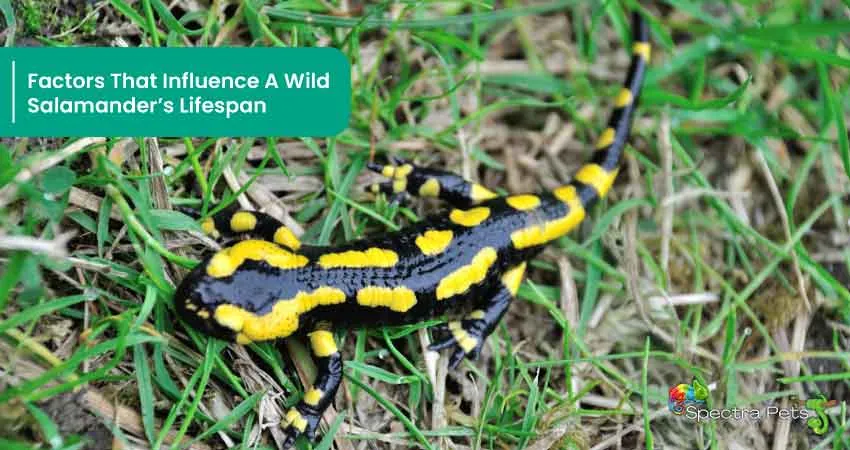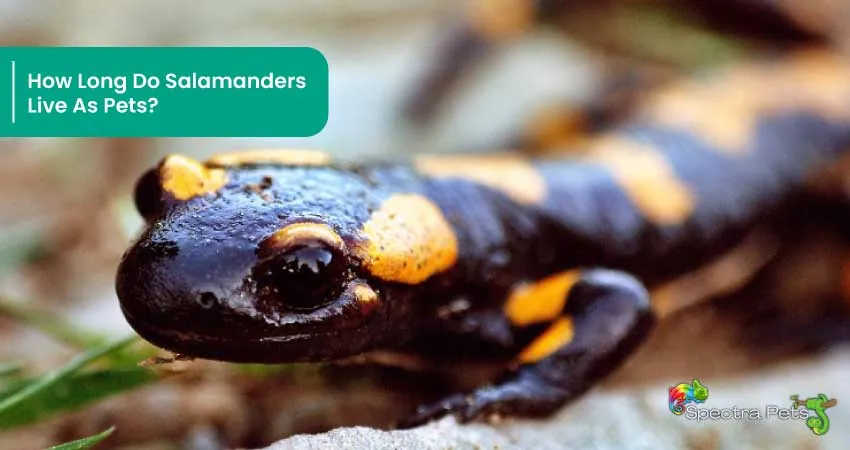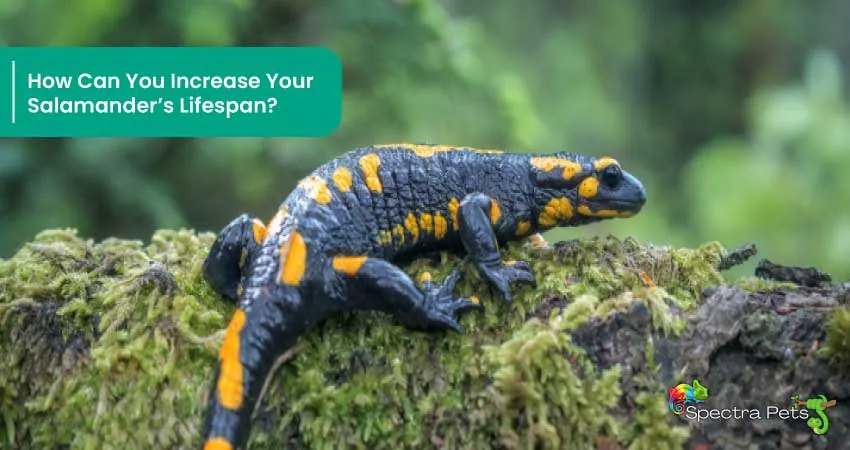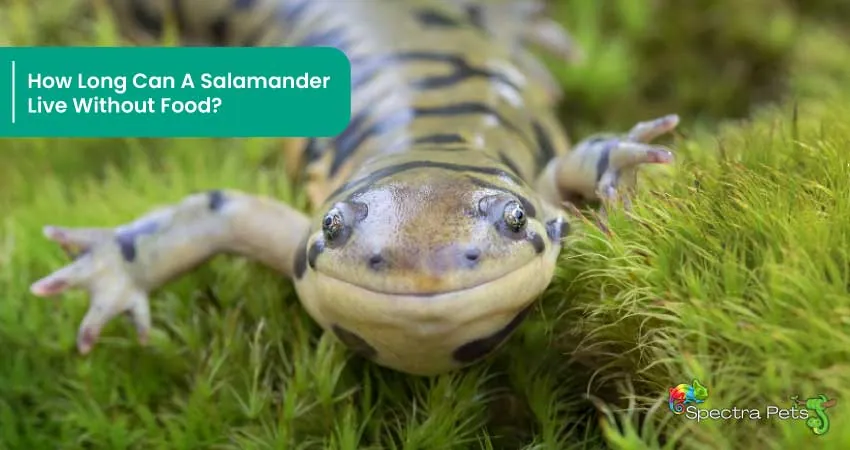Knowing how long a pet lives is crucial for a pet owner. You can get information about a cat or dog’s lifespan virtually anywhere, even general people are aware of it. But not everyone knows about salamanders.
Though their maximum life expectancy is not known, salamanders typically live anywhere from 5 to 25 years in captivity. The lifespan of a salamander, however, can vary greatly from species to species. Some species of salamanders live for only a few years, while others can live for decades.
In this article, we will explore what factors influence a salamander’s natural lifespan, as well as how humans can help them to enjoy longer lifespans when kept in human care. So, read on for some fascinating salamander facts and information about how you can make sure your pet salamander enjoys a long-term stay at home.
Factors That Influence A Wild Salamander’s Lifespan

There are several factors that can influence the lifespan of a salamander. You will find more about them down below:
Species
The lifespan of a salamander can vary depending on its species. Some species of salamanders have longer lifespans than others. For example, the Chinese giant salamander, which is the largest salamander in the world, can live for up to 50 years in the wild, while the fire salamander, which is native to Europe and North Africa, can live for up to 20 years in the wild.
Diet
Salamander food plays an important role in determining its lifespan. It’s not a surprise really, considering what us humans eat also affects our lifespan in the long run too.
In general, salamanders that have access to a varied diet tend to live longer than those who don’t. This means providing the right food sources such as insects, worms, and other small invertebrates. I have a complete list of the best salamander foods if you wish to check that out.
Additionally, those who feed on plants or fish eggs may be able to survive better in some environments due to their reduced competition for resources.
Size
Larger salamanders generally have longer lifespans than smaller ones. This is because larger salamanders have a greater capacity to store energy and are less vulnerable to predators.
Habitat
The habitat in which a salamander lives can influence its lifespan. Salamanders that live in more favorable conditions, such as those with plenty of food and clean water, are more likely to live longer than those that live in less favorable conditions.
Threats
Salamanders are vulnerable to a variety of threats, such as predators, disease, and habitat loss. These threats can reduce the lifespan of a salamander and make it more difficult for them to survive in the wild.
Care And Environment
In captivity, the care and environment provided to a salamander can influence its lifespan. Providing a salamander with a suitable habitat, the right diet, and appropriate temperatures can help to ensure that it lives as long and healthy a life as possible.
Can Salamanders Live For 100 Years?

It is unlikely that salamanders can live for 100 years. While there is some variation in the lifespan of different species of salamanders, most species have a lifespan of less than 50 years. The Chinese giant salamander, which is the largest salamander in the world, is one species that has a relatively long lifespan and can live for up to 50 years in the wild. However, it is unlikely that any species of salamander can live for 100 years.
It is important to note that the lifespan of a salamander can be influenced by a variety of factors, including the habitat in which it lives, its size, and the threats it faces. Salamanders that live in more favorable conditions, such as those with plenty of food and clean water, are more likely to live longer than those that live in less favorable conditions. Similarly, larger species of salamanders generally have a longer lifespan than smaller ones.
In captivity, salamanders may be able to live longer than they do in the wild due to the protection they receive from threats such as predators and disease. However, even in captivity, it is unlikely that a salamander could live for 100 years. Providing salamanders with the right care and environment can help to ensure that they live as long and healthy a life as possible.
How Long Do Salamanders Live As Pets?

Under captive care, salamanders can live longer than they do in the wild. This is because they are protected from many of the threats that they face in the wild, such as predators and disease.
However, it is important to provide salamanders with the right care and environment to ensure that they live as long as possible. This includes providing them with a suitable habitat, the right diet, and appropriate temperatures.
A Chart on Various Salamander Species’ Lifespan
Here is a chart that shows the potential lifespans of different salamander species:
| Species | Wild Lifespan | Lifespan in Captivity |
|---|---|---|
| Axolotl | 5-6 years | 15 years |
| Fire Salamander | 14 years | 30 years |
| Spotted Salamander | 20 years | 30 years |
| Marbled Salamander | 7 years | 11 years |
| Tiger Salamander | 10-15 | 25 years |
| Mudpuppy | 11 years | 30 years |
| Slender Salamander | 8 years | 10 years |
| Two-lined Salamander | 7 years | 8 years |
| Giant Salamander | 45-50 years | n/a |
How Can You Increase Your Salamander’s Lifespan?

There are several things that you can do to help increase the lifespan of your salamander:
Provide A Suitable Habitat
It is important to provide your salamander with a habitat that meets its needs. This includes an enclosure that is the right size and has the appropriate temperature, humidity, and lighting.
Offer A Varied Diet
Salamanders require a varied diet in order to stay healthy. Offer your salamander a variety of live or frozen insects, worms, and other invertebrates as well as a high-quality commercial salamander food.
Keep The Enclosure Clean
Regularly clean and disinfect the enclosure to help prevent the buildup of harmful bacteria and parasites.
Handle Your Salamander Gently
Avoid handling your salamander too much, and be careful not to squeeze or drop it.
Protect your salamander from predators: Keep your salamander safe from potential predators, such as cats and other pets, by securing the enclosure and keeping it out of reach.
Seek Veterinary Care If Necessary
If your salamander becomes sick or injured, it is important to seek veterinary care as soon as possible. A veterinarian can help diagnose and treat any health issues that may arise.
By following these tips, you can help increase the lifespan of your salamander and ensure that it stays healthy and happy for as long as possible.
How Long Can A Salamander Live Without Food?

Most salamanders are able to survive for longer periods without food than other animals due to their ability to enter a state of torpor, in which their metabolism slows down, and they become less active.
However, the length of time that a salamander can survive without food will also depend on its size and the conditions in which it lives. Smaller salamanders may not be able to survive as long without food as larger ones, and salamanders that live in cold temperatures may be able to survive for longer periods without food than those that live in warm temperatures.
It is important to note that salamanders, like all animals, need a source of food to survive. Without access to food, a salamander will eventually starve and die. It is therefore important to provide salamanders with a suitable diet and access to food to ensure their health and wellbeing.
What Do Salamanders Do All Day?

Again, the daily activities of salamanders can vary depending on the species and the habitat in which they live. However, there are some general patterns of behavior that are common to many salamanders.
During the day, salamanders are generally inactive and will spend most of their time resting in cool, damp places, such as under logs or rocks, or in burrows. This behavior helps them conserve energy and regulate their body temperature.
At night, salamanders are more active and will typically emerge from their hiding places to forage for food. Many species of salamanders are carnivorous and will feed on insects, worms, snails, and other small invertebrates. Some salamanders, such as the spotted salamander, may also feed on small vertebrates, such as frogs and small rodents.
In addition to foraging for food, salamanders may also engage in other activities, such as mating and breeding. Many species of salamanders have elaborate courtship rituals and may engage in complex behaviors to attract a mate.
Overall, the daily activities of salamanders are largely centered around finding food, regulating their body temperature, and reproducing.
Frequently Asked Questions (FAQs)
What Is The Longest Living Salamander?
The longest living salamander is the Chinese giant salamander, which is the largest salamander in the world. It is native to China and can grow up to 5.9 feet (1.8 meters) in length and weigh up to 110 pounds (50 kilograms). The Chinese giant salamander is known to have a relatively long lifespan and can live for up to 50 years in the wild.
Can Salamanders Live Without Water?
Salamanders are amphibians and therefore always need access to water in order to survive. Like all amphibians, salamanders rely on moisture from the environment to keep their skin moist and to help them breathe. Without access to water, a salamander’s skin will become dry, and it will be unable to breathe properly.
Do all salamanders have the same lifespan?
No, the lifespan of a salamander can vary greatly depending on the species. Some species, like the red-backed salamander, only live for 5–8 years, while others, like the olm, can live much longer.
How can you tell how old a salamander is?
Unlike trees, salamanders don’t have growth rings that can be used to determine their age. However, scientists can estimate the age of some salamanders by looking at their size and other physical characteristics.
Time To Pack It Up
While we may never know the exact lifespan of a salamander, we can still learn about them and appreciate their presence. While not as well known as other amphibians, these animals remain an important part of many natural ecosystems globally. They can help control insect populations, improve water quality, and even serve as indicators of environmental health.
As more people come to understand their critical role in nature, it is vital that we recognize how essential they are and take action to ensure they have the necessary space needed to thrive. Doing so will ensure that future generations can enjoy the unique beauty these creatures bring to our planet.

